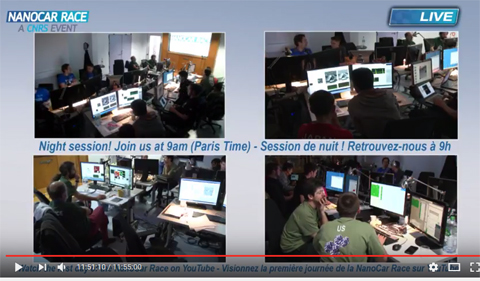
The Ohio University team drives the OHIO Bobcat Nanowagon from the control room in France. See the scholars in green, bottom right.
Just a few hours from the Indianapolis Motor Speedway—and deep in NASCAR country—one of the world’s tiniest, fastest racetracks was in Athens, Ohio, at the end of April.
The Track: Wasn’t that race in France? Yep. The world watched (live on YouTube) the control room in Toulouse—with the Ohio University College of Arts & Sciences team in green T-shirts—as six teams propelled their nanocars with Scanning Tunneling Microscopes in the world’s first nanocar race. But the OHIO team just happened to be using the STM here on campus.
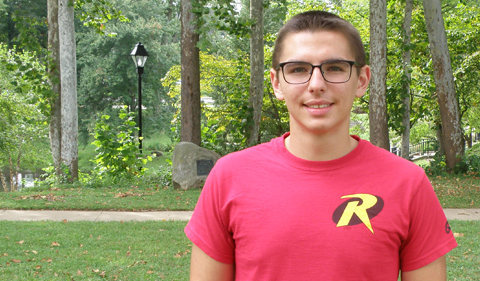
Ryan Tumbleson ’20 HTC Engineering Physics and Electrical Engineering undergraduate student, debuts as a driver
The Driver: At the same time that Dale Earnhardt Jr. was announcing his retirement, an undergraduate student at Ohio University was getting his chance behind the wheel. Ryan Tumbleson ’20 HTC was driving for one of six teams in the world. Read in his own words how he spent last summer at Argonne National Lab learning how to drive with physicist Dr. Saw-Wai Hla.
36 Hours: The 24 Hours of LeMans, another famous race held in France, can’t compete with the 36 hours of the Nanocar Grand Prix.
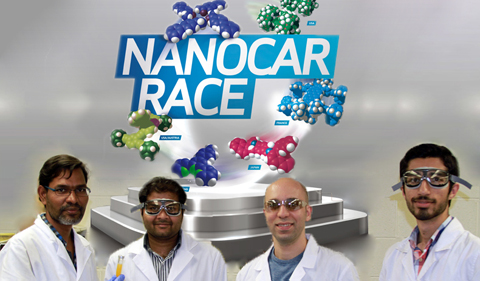
Nanocar participants Karthi Perumal, Kondalarao Kotturi, Mersad Raesi and Ramin Rabbani
The Constructors: In the Formula 1 Constructor Standings, Mercedes and Ferrari are just one point apart in the off-track competition that’s as fierce as the on-track racing. At OHIO, the physicists might do the driving, but chemists built the car. In Dr. Eric Masson’s lab, Graduate students Mersad Raeisi, Kondalarao Kotturi, Ramin Rabbani and post-doctoral associate Dr. Karthikeyan Perumal designed the world’s biggest tiny car—turning 700 atoms into one molecule—the OHIO Bobcat Nanowagon.

A monster truck: The OHIO Bobcat Nanowagon
The Texas Prize: They managed to get four wheels and a drive shaft into just one molecule. And their monster truck would take the Texas Prize for having the largest ever functional nanocar.

Dr. Saw-Wai Hla at a Scanning Tunneling Microscope (Photo by Rob Hardin)
The Fuel: If Top Fuel Dragsters are the fastest accelerating cars in the world—burning rubber, screaming decibels, and the sweet smell of nitromethane filling the air, then the nanocars might be the environmental answer. They are propelled by electric shocks from the conducting tip on a Scanning Tunneling Microscope.
The Pit Crew: These folks have been jumping back and forth over the wall in pit lane for almost a year, including manning the STM while everyone else was in France—physics graduate students Kyaw Zin Latt, and Sanjoy Sarkar.
The Results: Chemical & Engineering News writer Matt Davenport followed the action on and off the track with a compelling story about Ohio University’s team. Read on as he weaves the story–and reveals the checkered flag results.
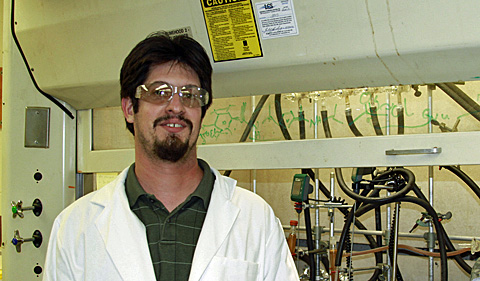
Dr. Eric Masson
Two Weeks Before the Race—Missing a Wheel?
Davenport visited Athens a few weeks before the race to check in on the team (and apparently the pit crew as well):
It’s hard to understand why Eric Masson’s excited about a picture of his car with a missing wheel. The fact that the car in the sepia micrograph on his computer screen looks more like a toasted marshmallow than a Maserati doesn’t help, either. But Masson, a supramolecular chemist at Ohio University, patiently explains that the lumpy, cream-colored rectangle he’s pointing to in the scanning tunneling microscope (STM) image is an assembly of atoms that scientists can drive across a surface. It is a nanocar.
There are several similar rectangles in this STM image. All of them, except for one, feature four discernible lumps, one at each corner. These lumps are nanocar wheels made of large, ring-shaped cucurbituril molecules.
But the car Masson’s pointing at has only three lumps. Resting nearby is a bright circle—a cucurbituril wheel lying on its side.
The car missing its wheel refuses to move, Masson has learned from his colleague and STM sage, Saw Wai Hla. Perplexingly, this is exciting news.
Masson, Hla, and their coworkers make up one of six international teams preparing for the first-ever nanocar race on April 28 in France. Because Ohio University is within driving distance of C&EN headquarters—using a macroscopic car, of course—we were able to visit the team.
So here we are, two weeks before the race, staring at the team’s immobile three-wheeler. The naïve nanocar observer wonders what happens if this hobbled molecule takes to the track against more ambulatory competition. The thought generates feelings closer to anxiety than excitement.
But Masson has a different, more complete view of his nanocars and the race as a whole. From a simple standpoint, the race is a friendly international competition that will showcase new STM technology at the French National Center for Scientific Research (CNRS) in Toulouse.
But the bigger picture is that the race is giving molecular machinists a platform to show where the field is headed. And, for the researchers involved, synthesizing and racing the nanocars has presented rich opportunities to push the limits of new technology and learn new science, Masson says.
That helps explain why he’s excited about the broken, motionless car. It raises a host of questions he and his team could choose to answer for the first time. For example, why isn’t it moving? And for the four-wheeled cars that do move, do the wheels skid or roll along the surface? (The team has started looking into that question, and early evidence suggests rolling, Masson says.)
Kudos to graduate students Latt and Sarkar. “They are the ones who found the broken wheel to prove that the wheels are intact in nanocars,” says Hla.
Six Cars, But Only Four STMs? OHIO Uses ‘Remote Control’
In France, organizers are responding to a Facebook question: “There are six teams but only 4 STM tips (at the University of Toulouse, site of the race). How will this work?
The STMs are the “engines” pushing the molecular cars.
Writer Davenport reports the solution:
Remember, though, there are six teams. All of them will be present in Toulouse, but the Ohio team and a team of Austrians and Americans will remotely control their cars. Thus, only four nanocars will physically be in Toulouse.
The remaining two will be controlled by pilots in Toulouse linking up to their own STMs in Ohio and Austria, Ohio’s Hla says.
That means Ohio’s drivers will be moving an STM tip and their car with nanoscopic precision from across an ocean. If that impresses Hla, it doesn’t show. “That’s today’s technology,” he says, matter-of-factly.
‘It’s Like a Monster Truck’
Davenport notes that the six competitors are very different, with the Swiss team’s entry more like a hovercar. The Volkswagen-sponsored German entry resembles a flat windmill.
Japan’s nanocar, sponsored by Toyota, moves like an inchworm.
But OHIO’s entry has wheels and a drive shaft. And it’s big.
The defining feature of the Ohio team’s Bobcat Nano-wagon is its wheels. Focusing on these, however, rolls over a complicated synthesis executed by grad students Mersad Raeisi, Kondalarao Kotturi, Ramin Rabbani, and postdoc Karthikeyan Perumal.
The crew perfected a process that linked a terphenyl drive shaft with axles made from 4-phenylpyridine groups using benzimidazolium motifs, Raeisi explains. This frame is comparable in size to other cars in the contest, but adding the cucurbituril wheels makes it the most massive of the racing molecules.
It’s about four times heavier than the next closest competitor, Masson says, although weight doesn’t matter much at this scale. Still, that doesn’t stop the team from affectionately joking about their molecule.
“It’s like a monster truck,” Kotturi says. “It’s a real American car,” Rabbani adds.
‘Apparently These Things Fly’
Earlier in Davenport’s visit to OHIO, he got a peek–courtesy of the Scanning Tunneling Microscope–at the Bobcat Nano-wagon’s potential.
Masson’s perspective is best captured in the three possible outcomes he sees for the race. The first is that the Ohio team wins. The second outcome is the team loses. The third is the team loses because its molecular car does something totally unexpected during the race. “That outcome is the most exciting one to me,” Masson says.
There is, however, one more feature in the image on Masson’s screen that suggests he’d also be happy with the first possibility. Between the lumpy rectangles are a handful of horizontal beige lines. The team thinks these are blurs in the image created by four-wheeled nanocars zipping by the STM probe as it “photographs” the surface. The molecular cars are literally streaking across the screen.
“Apparently these things fly,” Masson says, smiling.
Don’t Worry—Plenty of Back-Up Nano-Wagons on Pit Lane
Davenport explains in his article about looking at the Bobcat Nano-wagon molecules’ nuclear magnetic resonance signature on a poster outside Masson’s lab. “It conjures up an idea for a bumper sticker: My other car has an NMR spectrum.”
But this project is the marriage of chemistry and physics.
“Chemists can see that NMR spectrum and know they’ve got what they want, but we physicists need to see it,” says Hla, Ohio’s STM expert. And this brings us back to that image of the car missing the wheel.
Hla made that image by taking a solid nanocar powder, pumping it down to a vacuum inside the STM chamber, and then sublimating individual cars onto a surface at roughly 5 K. This is the same procedure each team will use to deposit its car onto the official racetrack.
Hla’s plan for the race is to line up several cars near the starting line. Being able to prep like this ensures the team can pick only four-wheeled cars, meaning that they don’t have to worry about the broken-down three-wheeled variety.
Having a “parking lot” near the starting line serves another purpose for the zippy Bobcat Nano-wagon. There’s a chance Hla or the team’s other driver, undergraduate student Ryan Tumbleson, could lose control of the speedy molecule during the race. If a car goes careening off the track, the driver can move the STM tip back to the starting line and start over with one of the waiting cars.
But speedy in this race is best measured in fractions of nanometers per minute. This, combined with the potential for any number of nanocar accidents, is why the teams have a maximum of nearly 40 hours to complete the race.
Taking Third–and the ‘Texas Prize’
Davenport’s story wraps up with a call at the finish line:
We learned on the day of the race that Hla’s uncertainty was warranted. Although the race was officially called after 30 hours, the Dipolar Racer sped across the finish line in just about 90 minutes, earning a first place finish for the team led by Tour and Grill.
This nanocar—a two-wheeler with tires made of adamantine—was so fast that the researchers had handicapped themselves by adding 50 nm to their racetrack in Austria. They also raced on silver instead of gold to further slow the car. Tour and Grill plan to publish the full design of the car, according to a press release from Rice.
About five hours later, the hovercraft-like Swiss Nano Dragster became the only car to complete the race on a gold track. CNRS declared the Swiss team a co-winner of the race, along with the U.S.-Austria team.
The Bobcat Nano-wagon got stuck 43 nm into the race, but it covered the most distance of the teams not to finish, putting the Ohio team in third place.
“Our nanocar was able to move as expected, and we learned quite a lot,” Hla says, adding that his team made history by racing a nanocar from across an ocean. This was made possible by grad students Kyaw Zin Latt and Sanjoy Sarkar, who maintained the STM in Ohio.
And the team earned another distinction in Toulouse, Hla continues. “We got the ‘Texan prize’ for operating the largest-ever functional nanocar.”
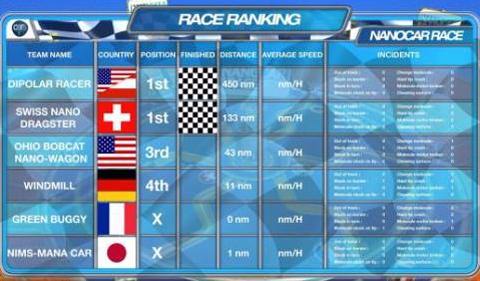
Ohio University takes third place at the world’s first nanocar race in France.


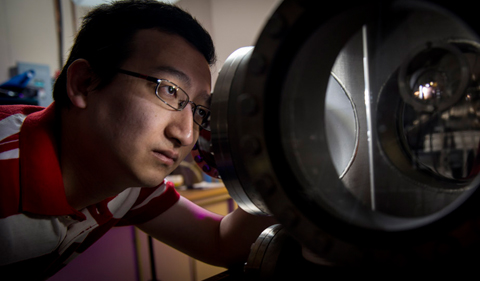


















Comments